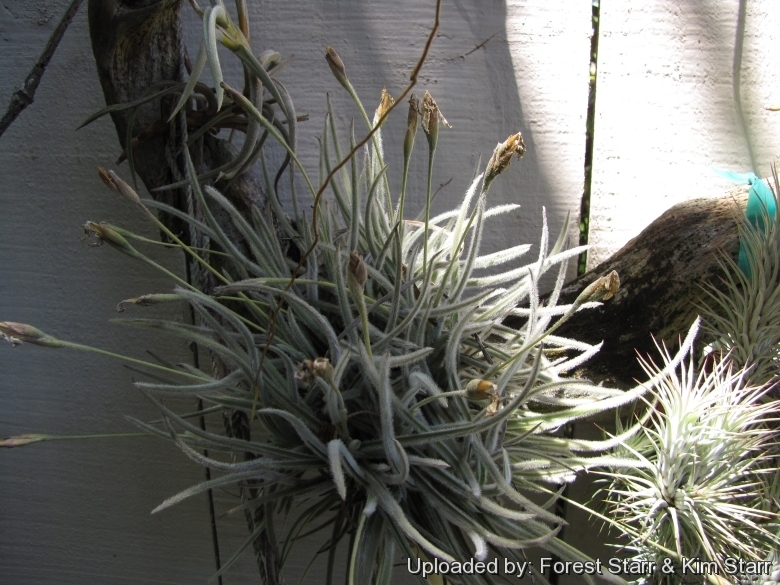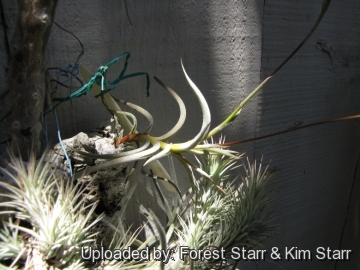Accepted Scientific Name: Tillandsia crocata (E.Morren) N.E.Br.
Suppl. Johnson's Gard. Dict. 1015 (1882) N.E.Br.

Phytarrhiza crocata (Tillandsia crocata) Photo by: Forest Starr & Kim Starr
Flowering habit at Ulana St Makawao, Maui, Hawaii (USA). April 11, 2010.
Origin and Habitat: Brazil, Argentina, Bolivia, Paraguay and Uruguay
Altitude: 900-2700 meters above sea level.
Synonyms:
See all synonyms of Tillandsia crocata
back
Accepted name in llifle Database:Tillandsia crocata (E.Morren) N.E.Br.Suppl. Johnson's Gard. Dict. 1015 (1882)Synonymy: 3
back
Common Names include:
ENGLISH: Air plant
FRENCH (Français): Tillandsia raquette
PERSIAN (فارسی): تیلاندزیا سایانیا
SWEDISH (Svenska): Blå tillandsia
UPPER SORBIAN (Hornjoserbsce): Módra tilandsija
Description: Tillandsia crocataSN|28150]]SN|28150]] is a xerophyte, epiphytic or saxicolous (rock-dwelling) bromeliad with silvery grey-green leaves. It may be simple or or spreading through few branched horizontal rhizomes and forms miniature bundled clumps about 10-20 cm tall and wide. Its delightful yellow flowers waft one of the strongest and most delightful fragrance of any Tillandsia and warrant its great desirability among collectors.
Stem: Short-stemmed
Rosettes: Untidy with distichous (in opposing rows), spreading, and slightly recurved or reflexed leaves.
Leaves: Up to 15 cm long, tough, linear, attenuate, involute, stems like, semi-cylindical and channeled on the top surface, greenish to grey-green, with entire margins, coated by dense silvery coarse scale-like trichomes, the wings of which are large and elongated on one side. By rising up from the leaf surface, the wings aid in the epidermal drying process by facilitating greater air movement. This faculty is essential for clumping species that receive water frequently at certain times of the year.
Inflorescence: It produces a fine extended scape that subtends the simple, distichous inflorescence with 2-4 flowers. The densely lepidote floral bracts are imbricate.
Flowers: Funnel-shaped, bright canary-yellow or buttercup-yellow, that have 3 petals with one of the sweetest fragrances in all the bromeliad world.among gray-scaled floral bracts.
Blooming season: Spring.
Fruits: Septicidal capsules.
Bibliography: Major references and further lectures
1) Forest & Kim Starr “Tillandsia crocata (Hair plant)”. Plants of Hawaii. <http://www.starrenvironmental.com>. Downloaded on 20 August 2014.
3) Wikipedia contributors. "Tillandsia crocata." Wikipedia, The Free Encyclopedia. Wikipedia, The Free Encyclopedia, 6 Jul. 2014. Web. 18 Sep. 2014.
3) David H. Benzing “Bromeliaceae: Profile of an Adaptive Radiation” Cambridge University Press, 06/Apr/2000
4) Paul T. Isley “Tillandsia: the world's most unusual air plants” Volume 1 Botanical Press, 1987
5) Peter Loewer “The Evening Garden: Flowers and Fragrance from Dusk Till Dawn” Macmillan Publishing Company, 1993
 Flowering habit at Ulana St Makawao, Maui, Hawaii (USA). April 11, 2010. (Tillandsia crocata) Photo by: Forest Starr & Kim Starr
Flowering habit at Ulana St Makawao, Maui, Hawaii (USA). April 11, 2010. (Tillandsia crocata) Photo by: Forest Starr & Kim StarrSend a photo of this plant.The gallery now contains thousands of pictures, however it is possible to do even more. We are, of course, seeking photos of species not yet shown in the gallery but not only that, we are also looking for better pictures than those already present.
Read More... Cultivation and Propagation: Tillandsia crocataSN|33029]]SN|28150]] is easy to grow, drought tolerant, and will thrive within a broad latitude of care conditions. Locate in a well ventilated place. Tillandsia crocataSN|28150]]SN|28150]] is perhaps the best of the fragrant tillandsias for cultivation due to its tiny size.
Soil: This species prefers to be grown without soil mounted on wood or grown bare root on slabs of bark or tree fern fibre or on nearly any substrate. A and, if potted, it must be in a free-draining soil (i.e. leaf mold, peat and sphagnum added with perlite, sharp sand or orchid bark). pH Range 5,5 to 7,5.
Exposure: This plant likes bright indirect light and protection from hot sun, it is best placed in a sheltered spot in the garden during the summer to facilitate flowering. In a dark location the plant will gradually weaken and wither.
Fertilizing: It should be watered with a liquid fertilizer diluted to ½ the strength recommended on the label added to the current irrigation water once a month from spring to autumn. Can also be applied to the leaves.
Waterings: Allow medium to dry out between watering. From mid spring through fall, mist daily. If grown outdoors, keep dry during winter. Tillandsia crocataSN|28150]]SN|28150]] is quite drought tolerant, however because of its small size cannot survive lack of water or humidity for as long as more succulent and larger-leaved species such as Tillandsia duratiiSN|28150]]SN|33029]]. All of the leaf surfaces should dry between waterings. If the plants in a clump become wet and remain so for a few days they may suffocate and die. In a clump, air cannot circulate among the leaves as well as in individual plants.
Temperature: It must be grown in a frost-free situation in open air in the tropical and humid subtropical climates, with temperatures which it is good to keep over the 8°C, best 20-24°C.
However its cultivation can be tried also in the warm temperate climates, in sheltered position, as it can stand, for short time, temperatures around the -2°C (but plants foliage will suffer little cold damage where frost settles on them). Winter hardy to USDA Zones (9b-)10-11. North of Zone 10, this bromeliad is usually grown in containers that must be overwintered indoors.
Pest & diseases: No serious insect or disease problems. Watch for aphids, thrips and scale. Mealybugs infestations are also a frequent problem. Rot may develop if soil is kept too moist.
Maintenance: Transplant them in spring
Propagation: Division or seed. The primary plant tends to die off after flowering, but will be replaced by the offshoots. Plants can be divided at any time of the year. Seeds are germinated on peat moss. Seeds need light to germinate.










